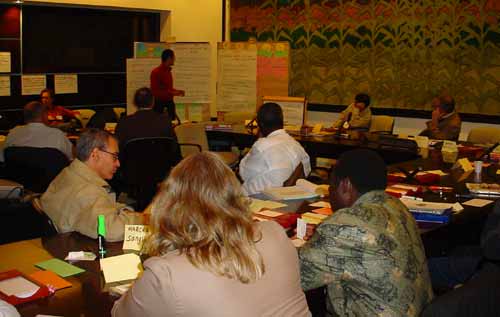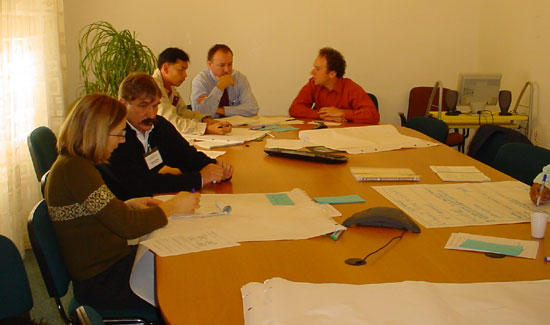The process and outcomes of the Technical meeting
As participants registered they moved into
the meeting room and reviewed the “board of partnership achievements”, posted
what they had accomplished from the activities identified in the last year’s
technical meeting and other key partnership or networking events/activities
they participated successfully in the past year.

After the opening words, short introduction and meeting overview, Mr
Fredrick Owino from Kenya gave a key note presentation:
“Some lessons from capacity building
for national forest programmes in selected African countries”.
He presented the variations in nfp process
among countries, the objectives of the qualitative assessment and the main
points and lessons learned. A short discussion followed the presentation to
share experience and insights. The presentation and discussion set the scene
and provided a good basis for further discussions during the meeting. The
paper with PPT presentation is attached in annex 3.
Presentation of country experiences from different regions
The meeting continued with the presentation of case studies
on practical experiences in endeavours to assess stakeholder participation
in nfp from Uganda (Annex 4) and Kyrgyzstan (Annex
5). The presentations were closed with the presentation by Dr. Buttoud
untitled “Assessment of participatory processes in nfp ; some basic (and also
disturbing) questions” (Annex 6). Each presentation was followed by short
group conversation to share experiences and insights.
For each presentation a pair of participants
was identified as “listening team” which had the responsibility to identify
what works and what doesn’t work in the assessment of the participatory process
illustrated in the case studies. The results of the listening teams were collected
and exposed on the wall for further reflection and inspiration (Annex
7).
Preparation and practical organization of group work sessions
Before dividing the participants into
working groups, a short presentation was made in plenary by Dominique Reeb to
define the national forest programme for the sake of the meeting to have the
common understanding of what is meant by nfp, participation, stakeholder,
criteria, indicators.
The nfp process was presented graphically and three first phases
of the process were chosen to help focus the work in working groups. The three
chosen phases were : i) Organization of the process ii) Analysis and iii)
Programme development. The details of the presentation are in annex
8.
Identification of criteria and indicators to assess participation in national
forest programmes
The participants were divided in three groups, each group took
one of the three phases of the process and had the same task : to identify
key stakeholders, try to classify them in function of their importance and
their power to influence the decision, and to propose the criteria and indicators
to assess their participation at the given phase of nfp process.

The groups were encouraged to start with
the classification of the stakeholders into the groups of importance/power
and to find the approaches to involve each of the group in the process. After
brainstorming the group proceeded with clustering the stakeholders, the approaches
to involve them and the criteria and indicators to assess their participation
in the given phase of the process. In each group a volunteer was identified
for reporting to the plenary (see annex 9 for the
full results of each group).
Plenary discussion
After the presentation of each group, the facilitator guided
an open discussion to reflect upon the result of the group work, to discuss
differences and similarities between the results of the different groups and
share opinions and perceptions on the criteria and indicators identified for
each phase of the process (Annex 10).
As a preparation for the next working session
the following focus question was asked to the participants in the plenary
:
What are practical ways to
facilitate the use of these assessment criteria and indicators?
Then participants were invited to work in
working groups to select few criteria and identify what could be done, when
and how to use these criteria in assessment of participation in each stage
of nfp process.
Identification of actions that facilitate the use of selected criteria
and indicators for assessment of participation in nfp process
Each working group selected
the most important criteria and identified the actions to be taken for using
the criteria in practical way. After the session each group presented
its actions to the plenary.
The results are listed in
annex 11.
Review
and discussion of 2003 activities and achievements, foundation of the Community
of Practice and action planning for the next year
After the plenary presentation of working
group’s results, the facilitator opened the last part of the meeting of the
Community of practice with the presentation of 2003 activities and achievements,
followed by the review of the concept of Community of Practice for its formal
approval by participants (Annex 12). The proposals
for next year meeting (topic, venue, organizers) were registered for further
development and decision (Annex 13).
The actions to be taken individually or together by the members
of the Community of Practice in 2004 were identified in a individual working
session and the action sheets (annex 14) were posted
by participants on the wall.
The afternoon session was closed by short presentation of the
Community of Practice Website http://www.fao.org/forestry/site/14690/en
, the access to the pages and the possibilities
of future development for networking and sharing information through the Website.




